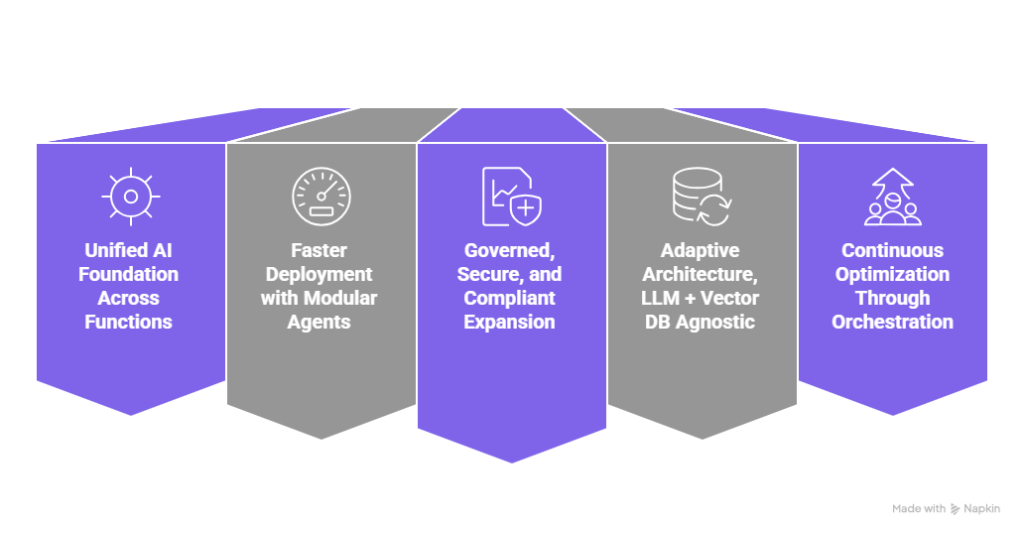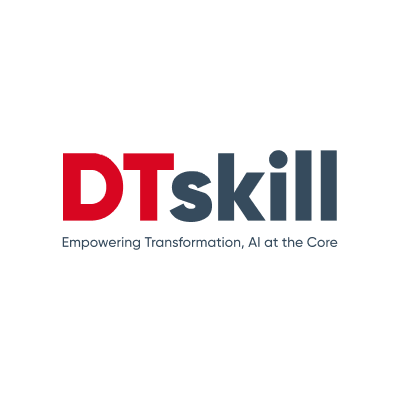Nearly 70% of enterprises struggle to scale AI in enterprise, according to multiple industry studies, not because they lack ambition, but because scaling intelligence across an enterprise is far more complex than deploying it.
A model that thrives in one department often falters in another. What works brilliantly for customer support rarely fits procurement, finance, or operations without rework.
What many leaders realize too late is that scaling AI isn’t just about replicating models; it’s about synchronizing how people, data, and workflows operate together. Without that coordination, even the most advanced models stay confined to pilots and proofs of concept.
True scale happens when AI moves fluidly across systems, learning from every interaction and improving decisions enterprise-wide.
And this is exactly what the GenE AI orchestration platform can do:
- Unifies enterprise systems under one orchestration layer.
- Automates AI workflows from prompt to execution.
- Integrates with any LLM or vector database, open-source or commercial.
- Delivers modular scalability, enabling AI to grow function by function.
It’s not another AI tool; it’s the layer that helps enterprises operationalize intelligence sustainably, making AI both repeatable and reliable across every function.
That brings us to a more fundamental question – why scaling AI truly matters for the enterprise.
Why Scaling AI Matters for the Modern Enterprise
Teams across departments have already proven that AI can improve accuracy, automate routine work, and surface insights faster than before. But those wins often stay local. The real value emerges only when organizations scale AI in enterprise and make intelligence flow seamlessly across every function.
When AI scales, it stops being a collection of projects and starts becoming part of how the enterprise operates. Sales learns from service data, procurement decisions inform finance, and operations continuously adapt based on real-time insights. Every model strengthens the next, creating a connected network of intelligence that learns and improves over time.
Here’s what that looks like in practice:

- Unified Decision-Making: A consistent intelligence layer connects functions, ensuring decisions are aligned and data-driven.
- Continuous Optimization: Systems learn from outcomes, using results from one process to improve another.
- Faster Execution: With enterprise AI automation, repetitive workflows run autonomously while teams focus on higher-value tasks.
- Cross-Functional Visibility: Leaders gain clear visibility into how AI impacts performance, from productivity to profitability.
At the foundation of this lies AI workflow orchestration, the mechanism that allows intelligence to move across departments and systems without friction. Without orchestration, AI stays fragmented. With it, enterprises build a scalable, collaborative AI ecosystem that compounds value across the organization.
That vision of connected, enterprise-wide intelligence is clear. The problem is getting there. Here’s why scaling remains out of reach for most enterprises.

Reason 1: Fragmented Systems Block Enterprise-Wide AI
Most enterprises have strong AI foundations, advanced models, skilled teams, and clear goals. Yet these strengths often stay locked within departmental boundaries. Each system runs independently, tuned for its own function, without a shared mechanism to exchange data or insights.
This disconnect means AI operates in pockets rather than as a connected network. A recommendation engine in sales doesn’t inform procurement, and predictive analytics in operations can’t feed into finance. The result is a patchwork of intelligence that delivers value locally but cannot grow beyond its silo.
Impact on the Enterprise:
- Insights remain isolated, preventing organization-wide learning and optimization.
- Redundant model development increases time and cost across departments.
- Decisions rely on partial data, leading to inefficiencies and missed opportunities.
- Lack of integration limits the reach of enterprise AI automation across workflows.
The first step toward solving this is establishing a connected infrastructure where systems exchange intelligence seamlessly. With enterprise AI orchestration, enterprises can integrate existing tools and data sources without rebuilding them, creating a shared environment where AI can truly scale across the organization.
Reason 2: Functional Diversity Creates Unscalable AI Models
Every department within an enterprise operates differently, not just in goals, but in data, processes, and decision logic. An AI model trained for customer interactions in service doesn’t adapt easily to procurement’s supplier data or operations’ scheduling logic. Each function’s context demands unique behavior, which makes replication across teams difficult.
As a result, enterprises end up with multiple models doing similar work under different rules. Scaling becomes a manual effort, retraining, customizing, and revalidating models every time a new use case appears. Instead of multiplying impact, AI becomes fragmented by function, slowing adoption and consistency across the organization.
Impact on the Enterprise:
- Model duplication increases maintenance effort and costs across functions.
- Cross-department AI reuse becomes nearly impossible, delaying innovation.
- Performance inconsistency leads to unreliable enterprise-wide outcomes.
- Scaling new use cases takes longer, limiting ROI from AI investments.
Addressing this challenge requires flexible AI architectures supported by centralized oversight. Establishing a unified orchestration layer ensures shared standards for data, logic, and governance while allowing departments the freedom to adapt AI to their specific needs. This balance between structure and autonomy enables true enterprise-wide scalability.
Reason 3: Lack of Central Governance Stalls AI Expansion
Enterprises often begin their AI journeys through multiple decentralized pilots, each built by different teams, using different datasets and tools. While this approach fuels experimentation, it also creates a fragmented landscape where AI projects operate in isolation. Without a central governance framework, there’s no consistent standard for data security, model validation, or ethical compliance.
As these fragmented systems expand, maintaining visibility, version control, and reliability across AI initiatives becomes increasingly difficult. Teams struggle to align AI outputs with enterprise goals, and leaders find it hard to quantify the true ROI of AI investments. Over time, this governance gap slows decision-making and increases operational risks.
Impact on the enterprise:
- Inconsistent data and model governance across departments.
- Difficulty in ensuring compliance and security at scale.
- Slower decision cycles due to limited visibility.
- Disconnected ROI tracking and accountability gaps.
How to solve this? Establishing a centralized AI governance framework is critical to sustain scale. Through AI workflow orchestration and unified model oversight, enterprises can monitor, measure, and manage every AI initiative from a single control layer, ensuring trust, compliance, and alignment with enterprise-wide objectives.
Introducing GenE – The Enterprise AI Orchestration Platform
GenE, DTskill’s AI orchestration platform, is designed to unify fragmented systems, align cross-functional AI efforts, and establish a single layer of intelligence that spans the enterprise. With GenE, enterprises gain structure, visibility, and scalability without having to overhaul their existing tech stack.
Key Capabilities of GenE:

1. AI Workflow Orchestration
GenE synchronizes tasks across departments by connecting AI models, data pipelines, and automation systems into one cohesive flow. It ensures every process from sourcing to support moves in coordination, reducing manual dependencies and speeding up decision cycles.
2. Enterprise AI Automation
Routine, repetitive actions across business units are automated intelligently using GenE’s orchestration layer. By linking AI agents with enterprise tools, it accelerates response times, eliminates silos, and improves operational consistency across all functions.
3. Centralized Governance & Control
Enterprises often struggle to manage compliance, versioning, and AI visibility across teams. GenE provides centralized control, enabling leaders to set policies, monitor performance, and maintain compliance from a single dashboard, ensuring governance at scale.
4. Modular, Scalable Architecture
Instead of forcing a one-size-fits-all approach, GenE offers modularity, allowing enterprises to scale AI by department while keeping integration seamless. This flexibility ensures that innovation in one function strengthens, rather than disrupts, others.
By bringing together orchestration, automation, and governance, GenE AI orchestration platform turns fragmented AI efforts into connected enterprise ecosystems, enabling scale that is both controlled and continuous.
Addressing Pain Points of Scale with GenE
GenE directly resolves the three most persistent AI scalability challenges that limit how enterprises operationalize AI.
By orchestrating workflows, connecting data systems, and standardizing governance, it enables organizations to scale AI in enterprise efficiently and sustainably.
| Enterprise Challenge | How GenE Solves It |
| Fragmented Systems Block Enterprise-Wide AI | GenE AI orchestration platform connects isolated tools, workflows, and systems through AI workflow orchestration, allowing data and processes to flow seamlessly across departments. |
| Functional Diversity Creates Unscalable AI Models | Using modular agents, GenE customizes AI behavior for each function while maintaining centralized orchestration, ensuring adaptability without fragmentation. |
| Lack of Central Governance Stalls AI Expansion | Through built-in governance and monitoring, GenE enforces standards, compliance, and visibility across all AI operations, ensuring every initiative aligns with enterprise objectives. |
By embedding enterprise AI orchestration at the foundation, GenE shifts AI from isolated experimentation to enterprise-wide execution — transforming scale into a structured, measurable capability.
Achieving Sustainable AI Scale Powered by GenE
Enterprises that aim to scale AI in enterprise often face diminishing returns when orchestration isn’t part of their foundation. GenE AI orchestration platform changes that by creating a continuous, connected layer where models, data, and workflows evolve together. It turns scaling into a structured, repeatable process rather than a fragmented rebuild.
How GenE enables sustainable scale:

✔️Unified AI Foundation Across Functions
Through enterprise AI orchestration, GenE links every function from sales to operations under one interoperable layer, ensuring each system communicates and scales together seamlessly.
✔️Faster Deployment with Modular Agents
GenE’s plug-and-play agents simplify enterprise AI automation, reducing deployment cycles from months to days while maintaining consistency and adaptability across workflows.
✔️Governed, Secure, and Compliant Expansion
Every AI initiative is traceable and compliant through GenE’s built-in oversight, ensuring organizations scale with confidence, security, and transparency.
✔️Adaptive Architecture, LLM + Vector DB Agnostic
GenE integrates with any model or vector database, keeping enterprises future-ready without vendor lock-in or infrastructure disruptions.
✔️Continuous Optimization Through Orchestration
By embedding AI workflow orchestration, GenE allows AI systems to learn, adapt, and improve in production, enabling real-time scalability and sustained value.
With GenE, scaling AI becomes a disciplined enterprise capability rather than an experimental pursuit. It ensures every team, system, and decision grows smarter together, making AI a living part of how the organization operates and evolves.
Conclusion
With the GenE AI orchestration platform, enterprises gain more than automation; they achieve harmony between intelligence and operations. Through enterprise AI orchestration and AI workflow orchestration, GenE makes scale structured, measurable, and continuous across every function.In a landscape where most struggle to scale AI in enterprise, GenE provides a path forward where orchestration replaces fragmentation and where AI becomes a connected, enterprise-wide capability.
